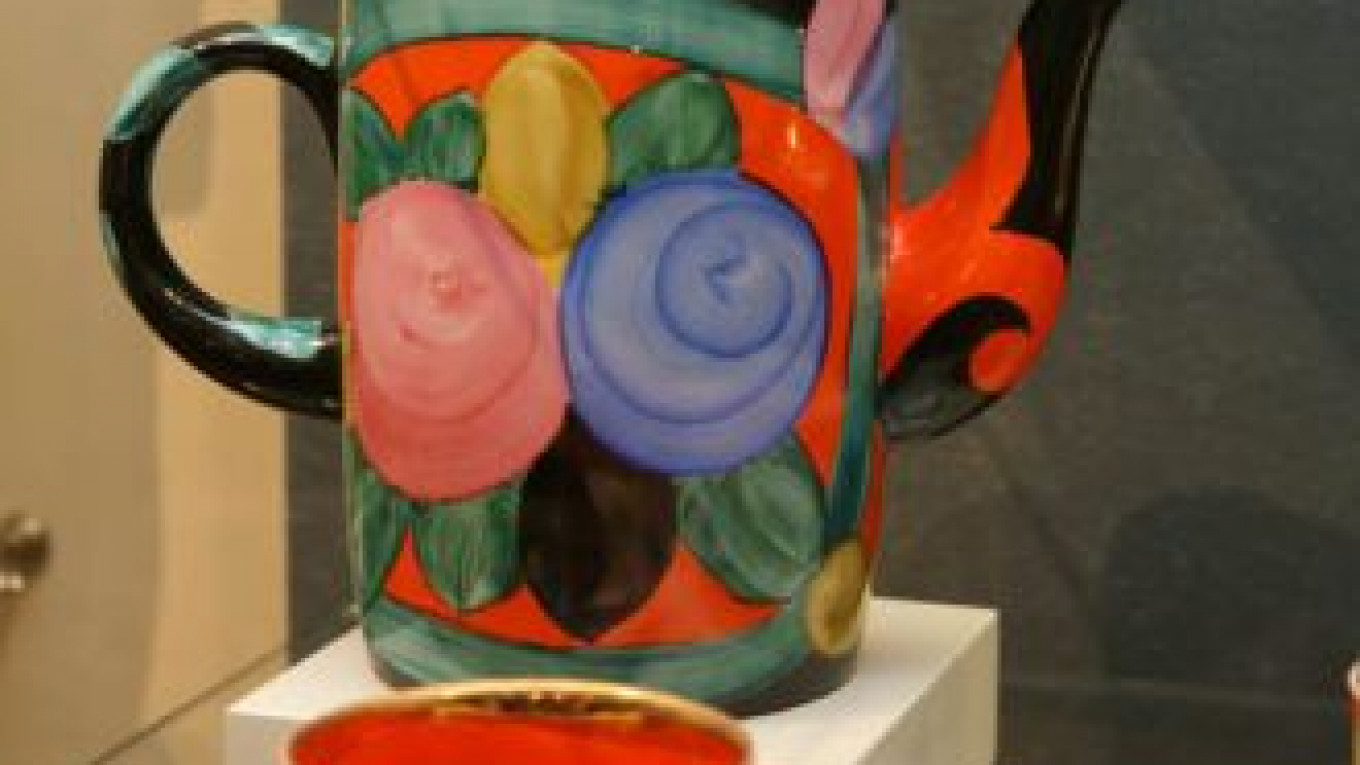Bolshevik leaders after the revolution urged the nation’s artists to produce high-quality and powerful propaganda. Many of the greatest avant-garde artists of the day captured the spirit of the young state by brandishing revolutionary slogans in poetry, theater, paintings and film.
Porcelain was no exception. Factories like Leningrad’s State Porcelain Factory, previously the Imperial Porcelain Factory, turned from producing dishware for aristocrats to producing it for the new Soviet regime. The 1920s saw phrases such as “He who doesn’t work doesn’t eat” and “The kingdom of workers and peasants will have no end” etched around the edges of dinner plates by masters of ceramic art.
These two plates are among the nearly 500 porcelain dishes and statues on display in a new permanent exhibition, “Masterpieces of Soviet Porcelain,” at the All-Russia Museum of Decorative-Applied and Folk Art. The exhibition displays rare masterworks crafted in the porcelain factories of Moscow and Leningrad from the 1920s through 1990.
“Twentieth-century Russian porcelain is a striking, unique page in the history of applied art not only in Russia but in the world. Such porcelain never existed before and will probably never exist again,” Larisa Karagodina, head of the contemporary art department at the State Ceramics Museum at the Kuskovo estate, said at the exhibition’s opening last month.
“This porcelain reflects all of the important events of the century and all its diverse and contradictory artistic trends,” she added.
Many of the exhibition’s pieces could be worth tens of thousands of dollars, said Yelena Vorushilina, the exhibition’s curator. Most of them are author’s editions, meaning that only a handful of copies were produced and each was signed by its artist. In some cases, similar designs would then be mass-produced for regular sale.
Some of the porcelain propaganda on show does not need slogans to make its point. A small ceramic statue from 1921 titled “The Awakening East” is of a Muslim woman with bared breasts removing her religious head-covering while reading a Soviet newspaper.
But not all of the works are propaganda. Most of the ceramic statues and dishware sets have no political agenda.
“In the first years after 1917, the artists weren’t under such strict supervision. They worked on various themes … Everything was possible, both propaganda art and subjects like nudes and the fall from Paradise,” said
Vorushilina.
Under Stalin, the regime clamped down on artistic freedom, and the 1930s saw porcelain tea sets and dishware decorated with artistic renderings of the construction of the Moscow metro and women riding tractors. Images became warmer and brighter after World War II, with images from Russian fairy tales and literature. Genre sculptures of everyday scenes arose. The exhibition includes a statue of an actor by sculptor Vera Mukhina, who designed Moscow’s Soviet-era monument “Worker and Kolkhoz Woman.”
Ceramic sculptors enjoyed freedom from the practical demands of designing for mass production.
“Sculptors at the factories in the 1950s worked on models for exhibitions and museums, very large-scale compositions,” Vorushilina said. They were artists rather than factory workers: “When you talk to the very old masters from those factories who are alive today, they say, ‘Why did they bother to keep us at the factories?’” she said.
Beginning in the 1960s, greater exposure to European art led Soviet porcelain masters to change their approach. While previously images had been painted on pre-formed dishware, artists began to regularly design the shape of the pieces themselves, resulting in sleek new forms.
“The 1960s brought an interest in the porcelain material itself… The artist’s realization of his idea united form and decor,” Vorushilina said.
Artists conceptualized the appearance of an entire dishware set as it would be displayed in an exhibition and often played with a set’s composition. The exhibition ends with two tea sets from 1990 that combine Soviet history with new forms. “Industry” is made of intricate, squared shapes painted with rigid construction imagery. The pieces in “Space” are a warm white, with lids shaped like onion domes.
“Masterpieces of Soviet Porcelain” is at the All-Russia Museum of Decorative-Applied and Folk Art, 3 Delegatskaya Ulitsa. Metro Novoslobodskaya. Tel. 609-0165, www.vmdpni.ru.
A Message from The Moscow Times:
Dear readers,
We are facing unprecedented challenges. Russia's Prosecutor General's Office has designated The Moscow Times as an "undesirable" organization, criminalizing our work and putting our staff at risk of prosecution. This follows our earlier unjust labeling as a "foreign agent."
These actions are direct attempts to silence independent journalism in Russia. The authorities claim our work "discredits the decisions of the Russian leadership." We see things differently: we strive to provide accurate, unbiased reporting on Russia.
We, the journalists of The Moscow Times, refuse to be silenced. But to continue our work, we need your help.
Your support, no matter how small, makes a world of difference. If you can, please support us monthly starting from just $2. It's quick to set up, and every contribution makes a significant impact.
By supporting The Moscow Times, you're defending open, independent journalism in the face of repression. Thank you for standing with us.
Remind me later.


